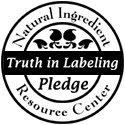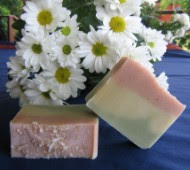Friday, January 22, 2010
Handmade Soap Giveaway
Then pop on over to Beautiful You for your chance at winning not one, but four bars of AromaBeauty All Natural Soaps.
While you're there have a read of some of the wonderful posts written by Julie, I’m sure you’ll love them as much as I do.
You will often see Julie in the media spreading 'Body Love' messages and talking about issues relating to self esteem, eating disorders and media literacy. I really admire Julie for the work she is doing in a lot of areas that really need addressing.
You’ll also notice the current interview which Julie very kindly offered to do, featuring me and my handmade soaps, so a big thank you Julie for this opportunity.
You only have till the 29th January to get your entry in, so don’t miss out, why not do it right now?
Sunday, January 17, 2010
Are Your Skincare Products Safe?
Every day we use numerous personal care products, that range from soap and shampoo to deodorant, toothpaste, lotions and make up, that contain chemical ingredients that are absorbed through the skin, inhaled or ingested.
So it’s not surprising that synthetic chemicals have gotten into our bodies and are causing all sorts of health problems. Surveys show that an average person uses as many as 25 different personal care and cosmetic products, containing more than 200 different chemicals.
Some of these chemicals are linked to cancer, birth defects, learning disabilities and other health problems that are epidemic in our society.
Studies have shown that we may actually acquire more toxins through skin absorption than through the foods that we eat; up to 70% of what is applied to the skin is believed to be absorbed into the body, what we use while bathing is able to be absorbed faster as that nice warm water opens our pores and lets either good or bad ingredients in.
Because the skin is the largest organ in the body, this is an extensive surface area through which toxic chemicals can enter. When you put chemicals on your skin, they can pass straight through and enter your bloodstream within minutes, this is the same way nicotine and birth control patches work.
Large corporations are filling their personal care products with all manner of synthetic petrochemical and oleo chemical emollients, thickeners, detergents, synthetic fragrances and preservatives, and to the great confusion of the consumer, are labeling these chemical products as “natural” and “organic”.
Why are these toxic chemicals still being used in our products when there are much safer alternatives now available? The problem is that safe ingredients cost a lot more, which means less profit, so synthetic chemicals are a much more profitable option for them to use.
You need to look at the claims of “naturalness” very closely. With no government regulation of the word “organic” in the personal care products industry, the use of the word “organic” has exploded in this market, with profits skyrocketing for the companies who take advantage of the consumers trust in organics.
A good way of detecting what sort of natural product you are buying is to carefully read its label.
Don’t be distracted by the mention of “natural” or “organic” on the front label, they’re betting that once you see either of those words you won’t take the time to read through the entire list of ingredients on the back, that's where you'll find if it contains chemicals or not. Don’t be fooled into just reading the front label, your health depends on it.
How do you know what chemicals are in the products you use?
I found the easiest way to read the ingredients listing on your products is to read each ingredient as it were something that you might put in your mouth, if it sounds like a chemical, then there’s a very good chance that it is.
According to the Environmental Defense group’s ongoing research, “78% of the chemicals in commercial use have not had even ‘minimal’ toxicity testing”. This should send alarm bells ringing; no wonder we have so many health issues!
What are some of the harmful ingredients being used in our personal care products?
- Acrylamide
- BHA (ButylHydroxyAnisole) and BHT
- Carbomer
- Cetareth
- Coal tar
- DEA and Cocamide DEA (Diethanol Amine)
- Diazolydinyl Urea and Imidazolidinyl Urea
- Dioxins - 1,4 Dioxane
- EDTA
- Ethylacrylate
- Ethylene oxide
- Formaldehyde
- Methylene Chloride
- Paraben Family, there are many: methylparaben, ethylparaben, propyllparaben, butylparaben etc
- PEG stearates (Poly Ethylene Glycol)
- Petroleum distillates
- PGB's
- Phenolics
- Phthalates and Dibutyl phthalate
- Polysorbatges
- Propylene glycol
- Quatenium
- SLS or SLES (Sodium Laurel Sulfate or Laureth Sulfate)
- Touluene
- Triclosan
- Triethanolamine & TEA (Triethanol Amine)
These are just a few, there are many, many more.
It’s up to us to decide what ingredients we are happy to use on our bodies. Is it worth saving a few dollars buying synthetic body care products when there are now alternatives available? Are synthetic chemicals worth the risk to your health, now and in the future? Of course not, who wants to jeopardize their health? We just need to be aware of any dangerous ingredients contained in the products we use.
A good place to start is by reading the ingredients labels on your products to see just how many of these dangerous chemicals you and your family are using each and every day.
If you are unsure of what a chemical is you can go to www.cosmeticsdatabase.com where you can type the ingredient in and it will tell you everything you'd like to know about that ingredient.
If you'd like to find out a bit more about unsafe chemicals, a good place to look is www.safecosmetics.org and www.ewg.org/reports/skindeep where you'll find some really interesting reading.
Sunday, January 3, 2010
Happy New Year!
I’ve been reading the post by Rebecca Sparrow in today’s Sunday Mail and she’s put forward a brilliant idea. On the first Sunday of every month she is going to nominate a very worthy cause and ask everyone to donate $10 to it.
It could be global one month and local the next, but once a month she is asking you to find just $10 and give it to an organisation to help them make a difference.
Most of us can afford $10 a month, it’s a small amount but if enough people do it, it can make a real difference and even change someone’s life. This month she has nominated www.onethousand.org and you can read more about it in today’s Sunday Mail.
So come on everyone let’s change someone’s future today, I think it’s a great idea and I for one will gladly participate. I encourage everyone else who can afford $10 a month, to follow suit as well.
Thank you Rebecca for inviting us all to be a part of your venture, if we all join together and help, imagine how many life’s we can change today.
OK, I’m off right now to donate mine, how about you?

.jpg)
.jpg)
.jpg)







